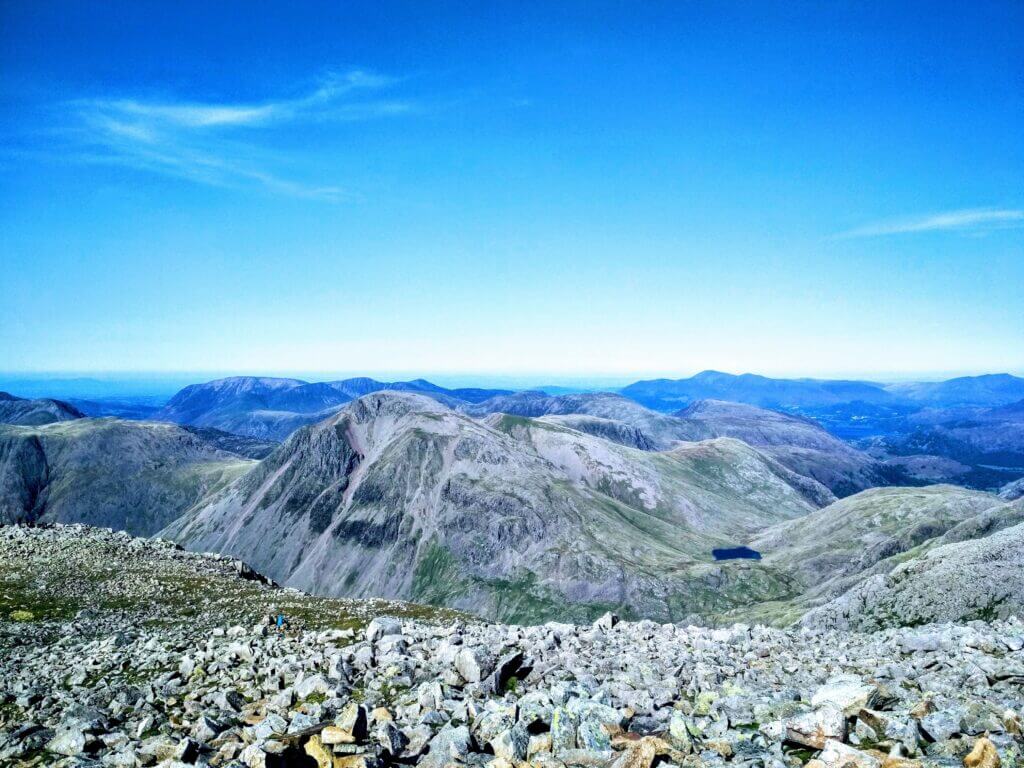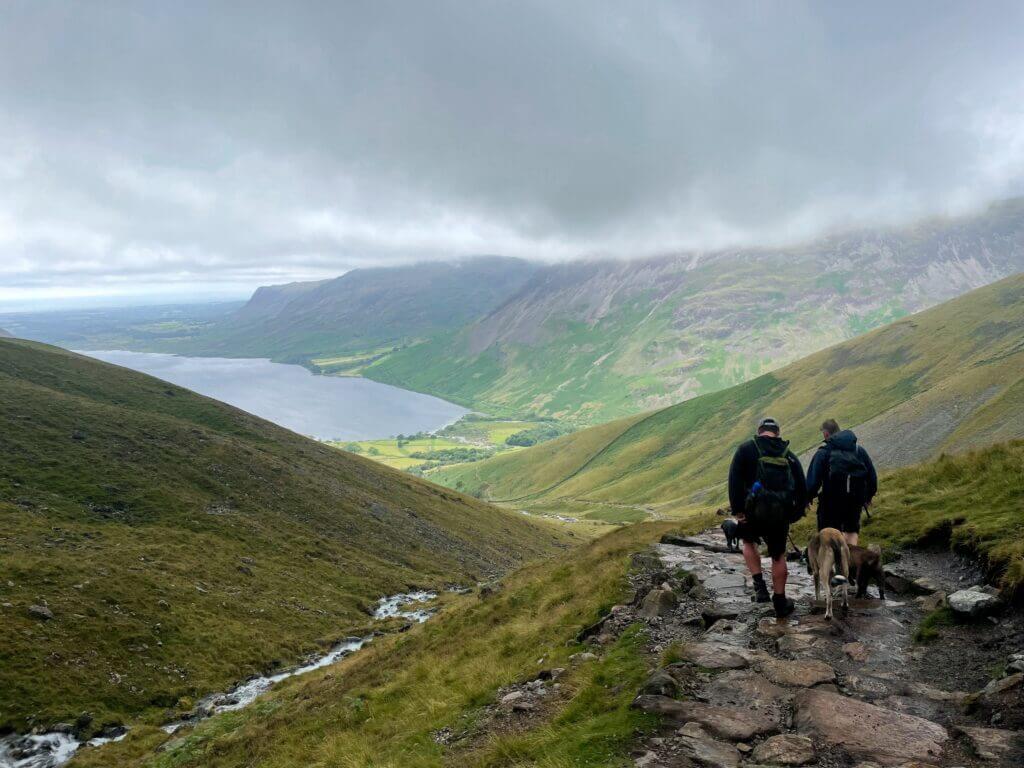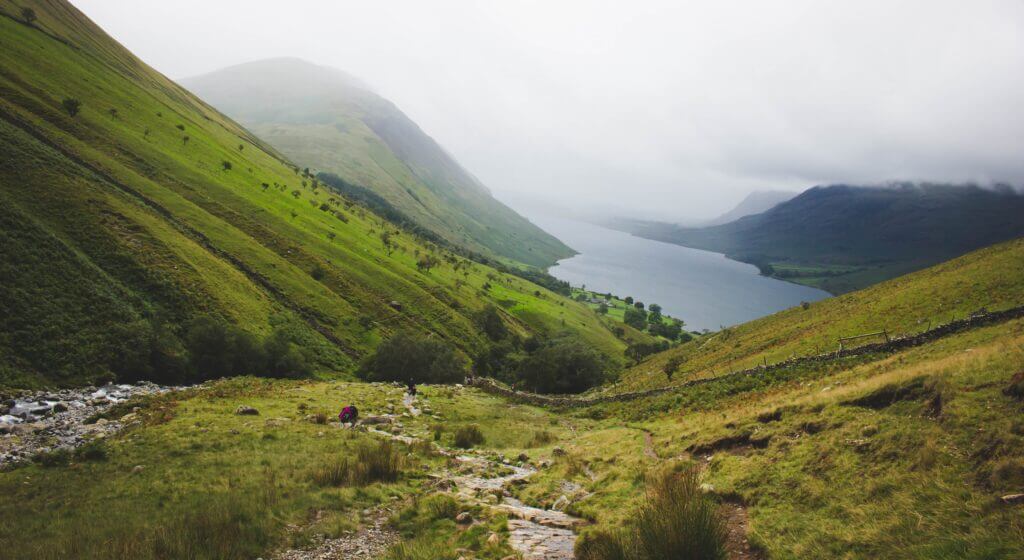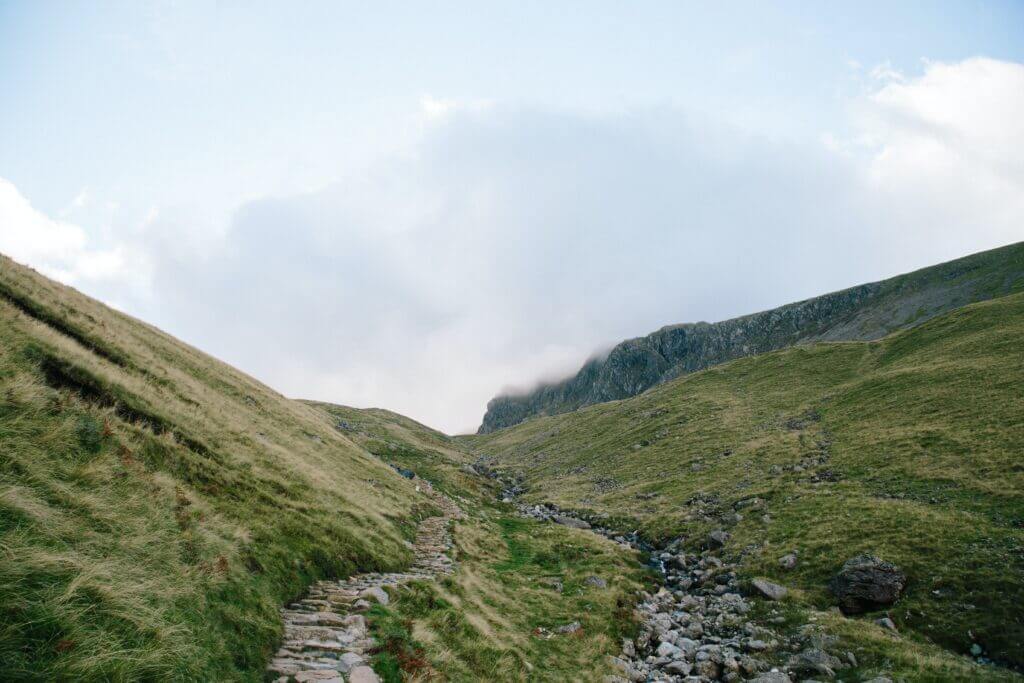Scafell Pike, the tallest mountain in England at 978 meters, is a magnetic destination for climbers and sightseers. Located in the beautiful Lake District National Park, the mountain is notable for its height and historical significance as a war memorial overseen by the National Trust.
The mountain offers a selection of three principal routes that cater to a range of climber preferences, each path beginning from a different side and delivering a unique journey to the summit. The route choice can significantly impact the climbing experience, offering anything from a direct ascent to a more varied expedition incorporating multiple peaks.
Selecting the appropriate route requires careful assessment of several factors, such as climbing ability, desired challenges, starting point’s geographical convenience, and the appeal of other peaks along the climb. Despite being the smallest of the National Three Peaks, Scafell Pike’s climb requires substantial planning and a respectful approach due to its unique challenges.
Scafell Pike is an integral part of the revered Three Peaks Challenge walks. It provides a thrilling trek against the stunning Lake District backdrop. The ascent is far from easy. However, each route symbolises effort and endurance. They invite climbers to appreciate the splendour of England’s highest point. Despite its size relative to its peers, Scafell Pike promises an enriching adventure. This promise is for those who take up the challenge to reach its summit.
| Key Fact | Detail |
|---|---|
| Height | 978 m or 3,209 ft |
| Main Routes | 1. Wasdale Head (most popular and shortest) 2. Dungeon Ghyll in Great Langdale 3. Corridor route via Wasdale 4. Boot in Eskdale 5. Seathwaite in Borrowdale |
| Difficulty | Smallest of the National 3 Peaks |
Scafell Pike, Main Routes

Scafell Pike, England’s highest mountain, offers explorers five distinct walking routes, each delivering a unique climbing experience and view.
These options include the popular Wasdale Head route, known for its direct and efficient ascent, and alternatives such as the paths from Dungeon Ghyll in Great Langdale, Boot in Eskdale, and the trails from Seathwaite in Borrowdale and Wasdale. Each route has its unique allure, from the scenic diversity of the Seathwaite Route and the Great Langdale Route to the tranquillity of the less-travelled Hardknott Eskdale route.
The right path choice requires careful consideration of factors such as speed, adventure, details, and personal preference, underscoring the idea that every Scafell Pike climb is a unique journey in its own right.
The Classic Path: Scafell Pike via the Wasdale Head
The Wasdale route, the preferred path for many ascending Scafell Pike, is a significant highlight of the Three Peaks Challenge. With a distance of 4.2 km and a 910 km ascent, this route offers a demanding but rewarding climb, typically taking around three hours to complete.
The journey commences at the Wasdale National Trust Car Park, an ideal location with essential amenities such as a hot food and drinks trailer, an information booth, and toilets. This well-appointed starting point, nestled next to a campsite, serves as a welcoming gateway to the mountain.
As one embarks on the Wasdale route, the steep start of the trail calls for occasional rest stops. Don’t be deceived by its popularity among tourists, as this path is rugged and can become indistinct halfway up, making it a challenging route even for seasoned climbers. The final ascent is particularly tricky, with a rocky and stony terrain adding to the challenge.
Despite the route’s steep and narrow paths, this small peak might resonate with climbers, making it the popular choice for those seeking an unforgettable mountaineering experience on England’s highest mountain.
A Longer Adventure: Scafell Pike from Great Langdale
The Great Langdale route to Scafell Pike is exceptional. It’s perfect for those seeking a lengthier, immersive adventure. It spans 9.3 km and ascends 1026m. The journey takes approximately 4 hours. This provides an enriching experience beyond a typical climb.
The route begins at the Old Dungeon Ghyll Hotel. It offers a unique chance to soak up breathtaking views of several renowned valleys in the Lake District. It also showcases a striking rock landscape. This enhances the appeal of the journey. This route suits those who value the adventure as much as the destination.
Parking in Great Langdale is readily available. The National Trust car park at Stickle Ghyll and the National Park’s Langdale car park provides ample vehicle space. These convenient facilities add to the overall ease and enjoyment of the Great Langdale route. This makes it an outstanding option for climbing Scafell Pike.

The Alternative Challenge: Scafell Pike via the Corridor Route from Wasdale
The Corridor Route from Wasdale Head offers a distinct pathway up Scafell Pike, presenting a blend of length and technicality, differentiating it from the traditional Wasdale route. This track spans 7.7 km, with an ascent of 967m, and is estimated to take around 3 to 4 hours to complete.
From the National Trust Car Park at Wasdale Head, hikers are met with various convenient facilities, including a pub and campsite at Wastwater. This ensures a comfortable and well-catered start to their adventure.
While this route is more commonly embarked upon from Seathwaite, the Wasdale Head Start presents an intriguing variation. The Corridor Route from here offers a less steep but more technical alternative, perfect for those seeking a different challenge on their ascent. The additional length allows for a more gradual climb, allowing climbers to fully absorb the majestic landscapes of Scafell Pike and the surrounding area. With ample parking available, the journey to the peak begins organised and hassle-free, setting the tone for an unforgettable expedition.
Off the Beaten Path: Scafell Pike from Hardknott Eskdale
The Hardknott Eskdale route to Scafell Pike offers a less frequented pathway to England’s highest peak. With a distance of 17.3 km and an ascent of 966m, this route, estimated to take approximately 6 hours, provides an alternative for those seeking a quieter and more untamed adventure.
Starting from The Woolpack Inn, this route offers a different perspective of Scafell Pike. Its reputation as a less-travelled pathway allows climbers to embark on a peaceful journey away from the crowds that typically populate the Wasdale Head route, particularly during the peak summer months.
This serene climb offers the unique allure of solitary exploration, making it an attractive choice for those who prefer solitude to conquer Scafell Pike. The Hardknott Eskdale route presents an opportunity to engage with the mountain’s more untamed side, offering an adventure steeped in tranquillity and the rugged charm of untouched landscapes.
Scenic Splendor: Scafell Pike from Seathwaite
The Seathwaite route, also known as the corridor route, is a remarkable pathway to the peak of Scafell Pike. With a distance of 7.27 km and an ascent of 876m, this route, which takes around 3 to 3.5 hours to complete, has captured the hearts of many climbers and is a prominent feature on numerous bucket lists.
Offering an enticing alternative to the often-taken Wasdale route, Seathwaite boasts a more accessible location near Keswick’s charming town. This route provides free parking and gives climbers higher-quality paths, enhancing the overall climbing experience.
The gradients on the Seathwaite route are generally gentler compared to other ways, making the ascent less strenuous and more enjoyable. What sets this path apart is the spectacular scenery it offers. Climbers are treated to some of the finest views in the Lake District, making the Seathwaite route an unmissable adventure for novice and experienced climbers.
Other routes up Scafell Pike

Scafell Pike from Wasdale Via Mickledore
Embarking on a trek to Scafell Pike from Wasdale via Mickledore promises an adventurous alternative to the more common paths. The journey begins and concludes at Wastwater in Wasdale, spanning a distance of 3.8km with a considerable ascent of 887m. This journey can be completed in an estimated 2-3 hours, depending on the pace and weather conditions.
This path begins with the same initial climb as the Brown Tongue route but deviates at Hollow Stones. The trail then heads directly towards the notable col at Mickledore instead of taking a left turn as one would on the Wasdale way.
Upon reaching Mickledore, Broad Stand greets walkers, a towering feature, only experienced climbers should attempt. You can find the final stretch up Scafell Pike from Mickledore by taking a path to the left upon arriving at Mickledore. Though less travelled, this route offers a stimulating challenge for those eager to experience a different side of Scafell Pike’s splendid scenery.
Climb up Scafell Pike via Piers Gill
The route via Piers Gill may be the hidden gem adventurers seek for a less frequented but equally thrilling climb up Scafell Pike. Commencing and culminating at Wasdale Head, this track covers a distance of approximately 5.9km with a substantial ascent of 889m. Depending on one’s hiking pace, this journey will take around 2 hours.
This route carves a unique path alongside the grand Piers Gill canyon, which majestically slices across Lingmell’s flanks, affording climbers spectacular views and a serene atmosphere away from the bustling crowds of the Hollow Stones and Corridor Route. This path is noted for its tranquil appeal and intimacy with the landscape as it winds up alongside the gill.
While this trail captivates, it also presents challenges. The journey involves several short yet steep scrambles that climbers can’t avoid, requiring fitness and skill. While the gill holds an undeniable allure, climbers must treat it with respect due to its history of accidents. Remember, it’s not feasible to walk up or down Piers Gill’s stream bed, and climbers should take safety precautions seriously. Despite its challenges, this route offers those up for the task an immersive, off-the-beaten-path experience.
Scafell Pike via Lingmell
Scafell Pike via Lingmell could be the perfect trek for the adventure-seeking hiker who appreciates less crowded paths. Commencing and concluding at Wastwater in Wasdale, this path covers an impressive 5km, with a vigorous ascent of 942m. A typical journey time stands at around 2.5 hours.
This path from Wasdale begins by following the customary routes to Scafell Pike but soon diverges by directing climbers uphill towards Lingmell. This divergence provides a more serene experience, as hikers can enjoy the less frequented path in relative solitude. For those setting off from Wasdale Head, the route is easily identified and signposted at the start, ensuring no confusion for the hiker.
Once the hike is underway from the National Trust Car Park at Wastwater, conveniently next to the campsite, the trail leads directly uphill along Lingmell Beck. This stretch offers a moderate challenge and ample natural beauty as the trail travels through the terrain. The Scafell Pike via Lingmell route is ideal for those who wish to escape the crowds and take the road less travelled on their ascent.
Scafell Pike From Eskdale and Boot – via Pen
Venturing on the path less travelled, the Scafell Pike route from Eskdale and Boot via Pen stands as a quiet invitation to the adventurous hiker. This unique route, starting and ending at Jubilee Bridge in Eskdale, spans 8.6 km and involves an ascent of 948 m. Hikers can expect to complete the journey in approximately 3.5 to 4 hours.
The route from Eskdale, via the quaintly named village of Boot, presents one of the longest and most secluded paths to the summit. Due to its remote location within Eskdale and Great Moss bounds, first-time climbers may find this route more challenging. The Hollow Stones or Seathwaite routes offer a more suitable alternative for those new to Scafell Pike.
Eskdale embodies the wild and largely unspoiled spirit of the Lake District. This valley, circled by some of the most iconic Lakeland fells, surprisingly sees few visitors. For newcomers, Eskdale may seem daunting with its lengthy walk-in, pathless navigation, bogs, and solitude. However, experienced hikers find these factors converging to create a memorable, exhilarating day in the fells, a testament to the untouched beauty of this rugged landscape.

Scafell Pike via Scafell – The Walker’s Route
Journeying via the Walker’s Route to Scafell Pike presents an unforgettable trekking experience. Starting and ending at Wastwater in Wasdale, this route is approximately 5.6 km long with an impressive ascent of 1134 m. Hikers should plan for about 4 hours to complete the journey.
Historically, Scafell was perceived as the highest mountain, with other hills merely viewed as the ”pikes” of Scafell. This route allows the ambitious walker to conquer Scafell and Scafell Pike in a single trip, providing a comprehensive and rewarding hiking experience.
A vital feature of this route is avoiding the Broad Stand climb. Instead, it takes adventurers on a descent via Fox’s Tarn. While this alternative means losing slightly more height than on Broad Stand, it is an optimal choice for those who aren’t avid climbers. So, gear up for an enticing walk that weaves through the heart of England’s breathtaking mountainous landscapes.
Best Time of Climbing Scafell Pike
Choosing the ideal time to climb Scafell Pike is crucial for a memorable and enjoyable mountaineering experience. A perfect period would be when the mountain is snow-free, with minimal rain and wind.
Between May and October, conditions are generally favourable for an ascent. Although summer can bring warmer temperatures and potentially low clouds and rain, it’s also the peak period for climbers, which can result in crowding on the trails.
To optimise the experience, it’s advisable to avoid July and August, as these months coincide with school holidays and often see an influx of climbers. For a more serene and less congested trek, late May to early June or mid-September, preferably on a weekday, is recommended. This timing allows for more parking options and an uncluttered mountain, making the climb more scenic and authentic.
For those willing to brave cooler temperatures, October to May can offer a unique experience. However, snow is expected at higher altitudes during these months, and freezing temperatures can lead to water ice formation. Therefore, carrying winter equipment and preparing for lower temperatures becomes a necessity.
Regardless of the chosen month, climbers should never forget that the summit temperature tends to be five to ten degrees lower than the valley temperature. Windchill can also be severe on the summit plateau at any time of the year, necessitating appropriate preparation and caution.
Weather Check of Scafell Pike
Understanding the weather conditions on Scafell Pike is integral to any successful and safe ascent. Given the unpredictable nature of mountainous weather, it’s critical to check the forecast before climbing. Although not consistently accurate, the projection provides valuable insight into potential weather changes that could impact the climb.
Undertaking the Three Peaks Challenge, which includes Scafell Pike, is ideally done in the summer months. This period traditionally presents fewer adverse weather conditions, potentially making the climb more manageable and enjoyable. However, it’s essential to continuously monitor the forecast in the days leading up to the trek. This practice allows for real-time adjustment of plans and preparation, ensuring a safer and more rewarding journey up the highest mountain in England.

Fascinating Facts about Scafell Pike
Immersed in a wealth of history and offering a stunning panorama of nature’s bounty, Scafell Pike is more than England’s highest mountain. A fascinating tapestry of interesting facts makes this mountain a magnet for climbers.
A participant in the National Three Peaks Challenge, Scafell Pike shares its status with the eminent Ben Nevis and Snowdon. Its natural features include Broad Crag Tarn, which at an elevation of 820 meters, is the highest standing water in England.
Adding to its allure, Scafell Pike was a generous donation by Lord Leconfield to the National Trust in 1919. This heartfelt gift was a tribute to the brave men of the Lake District who made the ultimate sacrifice during the First World War. The original terminology of Scafell Pike included Broad Crag and Ill Crag, all once collectively known as The Pikes of Sca Fell.
Wastwater Lake, residing within the folds of Scafell Pike Mountain, holds the title of the deepest lake in England. Measuring three miles in length, over half a mile wide, and reaching depths of 258 feet, it’s a sight to behold.
On rare, clear days, the summit serves as a vantage point. You can view distant peaks in Ireland, Scotland, and the Isle of Man. There are about five known routes to the summit. Often, the Wasdale Route offers the most direct and quickest path to Scafell Pike’s peak.
Frequently Asked Questions About Scafell Pike
Can a beginner climb Scafell Pike?
The answer is a cautious yes. The journey to Scafell Pike’s summit is indeed accessible to beginners, but it is advisable to undertake this challenge accompanied by a knowledgeable guide. This is not a climb to be underestimated; the ascent is demanding, and the mountainous environment can be challenging.
Weather unpredictability is a significant factor in this climb. Climbers may encounter severe conditions such as powerful winds, intense wind chill, and even snowfall, irrespective of the season. These potential difficulties underline the importance of adequate preparation and informed guidance for those beginners wishing to conquer Scafell Pike.
Which is the shortest route up Scafell Pike?
The Wasdale route earns this distinction. Initiating from Wasdale Head, this route, almost at sea level, immediately embarks on an ascent alongside Lingmell Gill. It presents an advantageous choice for beginners or those desiring a quicker hike.
Climbers should note that while they can easily follow the well-formed trail leading to the col, the final ascent from the col to the summit might be less straightforward. This segment has crags on both sides, introducing an element of challenge. Despite its brevity, the Wasdale route offers an engaging climb to Scafell Pike.
How hard is it to climb Scafell Pike?
It requires understanding that the ascent is challenging regardless of the chosen path and necessitates meticulous planning and preparation. Numerous climbers triumphantly reach the peak autonomously, their success testament to their diligent practice. However, a few less fortunate ones – perhaps those who haven’t prepared as extensively – encounter difficulties and require rescue. Each stride up Scafell Pike is a test of tenacity, proving that conquering this mountain is an accomplishment not to be underestimated.
Which route offers the best views when climbing Scafell Pike?
Each route to the Scafell Pike summit reveals stunning panoramas, but people often revere the way from Langdale for its visual diversity. This path traverses various other peaks, including Bow Fell and Esk Pike, gifting climbers with a rich tapestry of landscapes. On a clear day, the viewpoint from Bow Fell offers a particularly majestic sight of Scafell Pike itself, making the journey worthwhile. However, fewer climbers tread the Langdale route, and it demands thorough preparation and adept navigation skills. Every step this route takes brings you closer to the summit and its breathtaking vistas.
What do I do in an emergency?
In an unforeseen emergency while climbing Scafell Pike, being equipped with a whistle and a head torch can prove crucial. These can serve as indispensable tools to attract attention and signal for assistance, far more effective and less energy-consuming than shouting. A series of six blasts on a whistle or flashes from a torch at regular intervals can alert fellow walkers to a distress situation.
In more dire circumstances, dialling 999 is the recommended course of action. The initial contact should be with the police, followed by a request for Mountain Rescue. Essential information to relay includes the grid reference of the current location, the size of the party, and the nature of the incident. Navigating through emergencies requires calm and informed actions, and these steps serve as a vital guide in such situations.
Are there any guided treks available for Scafell Pike?
Indeed, guided treks offer a fantastic opportunity for those eager to extract the total value of their Scafell Pike journey. Expert mountain guides, well-versed in traversing England’s tallest peak, are available to accompany climbers. Their knowledge encompasses not only the practicalities of the ascent but also the hidden gems along the route. Guided treks enable climbers to focus less on navigation and more on absorbing the surrounding beauty, enriching the overall experience and offering a chance to appreciate the scenic spots that might otherwise go unnoticed.
How long will it take me to climb Scafell Pike?
The time required to conquer Scafell Pike is subject to several variables, including the chosen route, individual pace, and prevailing weather conditions. The Wasdale route is typically the shortest and fastest, often favoured by climbers eager to reach the summit swiftly. However, it’s critical to consider that factors such as pace and weather play a significant role in determining the overall time of the climb. Personal fitness level, the unpredictability of mountain weather, and the terrain’s difficulty may all contribute to the journey’s duration.
Do I need to take a map and compass?
Navigating Scafell Pike necessitates a good grasp of basic orienteering skills. The path to the summit is neither marked nor straightforward, making an OS Map an indispensable tool for climbers. Furthermore, the ability to use this map accurately can make the difference between a smooth, enjoyable climb and an unnecessarily arduous trek. Therefore, always carry an OS Map and familiarise yourself with its usage before climbing.
Can I wild camp on Scafell Pike?
Wild camping offers a unique way to fully experience the grandeur of Scafell Pike and the broader Lake District. It is generally accepted practice, provided it’s done within the recognised guidelines. These directives ensure that the area’s natural beauty and delicate ecosystems are preserved. So, for those adventurers craving an overnight stay beneath the stars, wild camping can be an enriching part of their Scafell Pike journey.


